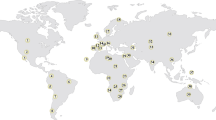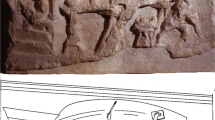Abstract
Rock art in Ethiopia is concentrated in the north, east, south, and south-central part of the country. Previous investigations focused on description and stylistic distribution of the art. A closer look at the mode of rendering the art allows grouping sites into three distinct assemblages: the northern assemblage of paintings and engravings, the eastern and southern assemblage of paintings, and the south-central assemblage of carvings. These paintings/engravings/carvings are executed mostly on sedimentary rocks (sandstone or limestone), but also on granite. The rock type on which art is depicted is not the most important factor for the type represented. Other avenues must be looked into to explain differences in the types of rock art distribution, as the striking inter-regional difference in rendering the rock art might epitomize specific culture areas.
Résumé
L’art rupestre en Ethiopie est. principalement concentré dans le nord, l’est., le sud et le centre-sud du pays. Des recherches antérieures portaient sur la description et la distribution stylistique de l’art. Un regard plus attentif sur le mode de rendu de l’art permet de les regrouper en trois assemblages distincts: l’assemblage nord des peintures et des gravures, l’assemblage oriental et sud des peintures et l’assemblage central-sud des sculptures. Ces peintures / gravures / sculpture sont exécutées sur grès ou le calcaire et rarement sur le granit. Le type de roche sur lequel ces art rupestres sont représentés n’est. pas le facteur le plus important pour le type d’art rupestre représenté. D’autres approches doivent être examinées pour expliquer les différences dans la distribution des types d’art rupestre, car la frappante différence interrégionale dans la représentation de l’art rupestre pourrait incarner une zone de culture spécifique.




Similar content being viewed by others
References
Anfray, F. (1967). Les sculptures rupestres de Chabbè dans le Sidamo. Annales d'Ethiopie, 7, 19–32.
Anfray, F. (1976). Les sculptures rupestres de Galma dans le Sidamo. Annales d’Ethiopie, 10, 53–55.
Assefa, Z., Pleurdeau, D., Duquesnoy, F., Hovers, E., Pearson, O., Asfawossen, A., Constantinos T/Tsion, & Lam, Y. M. (2014). Survey and explorations of caves in southeastern Ethiopia: Middle Stone Age and Later Stone Age archaeology and Holocene rock art. Quaternary International, 343, 117–135.
Asrat, A. (2002). The rock-hewn churches of central and eastern Tigrai: A geological perspective. Geoarchaeology, 17, 649–663.
Asrat, A., Baker A., & Negash, A. (2011). Geomorphology of the limestone terrain of Tigray, northern Ethiopia: Implications for cave formation and speleothem growth. A paper presented at the International Association of Geomorphologists. Addis Ababa.
Bachechi, L. (2003). Rock engravings at Ejerssa Gara Hallo (southern Ethiopia). Rivista Scienze Preistoriche, 52, 598–605.
Bachechi, L. (2005a). Le incisioni rupestri di Harurona Cave nel Wolayta. Antrocom, 1(2), 107–114.
Bachechi, L. (2005b). A few sites with rock engravings in south Ethiopia. Atti del Museo di Storia Naturale della Maremma, Supplement, 21, 79–98.
Bachechi, L. (2005c). Preliminary report on the 2002 excavation of Harurona cave deposit. Atti del Museo di Storia Naturale della Maremma, Supplement, 21, 67–78.
Bailloud, M. (1965). Chronique archéologique, 1960-1964, Part 11. Annales d’Ethiopie, 6, 9–11.
Barnett, T. (1999). Quiha rock shelter, Ethiopia: Implications for domestication. Azania, 34, ll–24.
Beyth, M. (1972). The geology of central-western Tigre. PhD dissertation. Rheinischen Friedrich-Wilhelms-Universitate, Bonn.
Bosellini, A., Russo, A., Fantozzi, P., Getaneh, A., & Tadesse, S. (1997). The Mesozoic succession of the Mekele outlier (Tigre province, Ethiopia). Memorie Scienze Geologiche, 49, 95–116.
Bosselini, R., Russo, A., & Getaneh, A. (2001). The Mesozoic succession of Dire Dawa, Harar Province, Ethiopia. Journal of African Earth Sciences, 32(3), 403–417.
Brandt, S. A., & Carder, N. (1987). Pastoral rock art in the Horn of Africa: Making sense of udder chaos. World Archaeology, 19, 194–213.
Breuil, H. (1934). Peintures rupestres préhistoriques du Harrar (Abyssinie). L’Anthropologie, 4, 473–483.
Carder, N. (1988). Modeling the evolution of pastoral rock art in the Horn of Africa. MA thesis, University of Georgia.
Cervicek, P. (1971). Rock paintings of Laga Oda (Ethiopia). Paideuma, 17, 121–136.
Cervicek, P. (1976). Rock engravings from the Hamasen region, Eritrea. Paideuma, 22, 237–256.
Cervicek, P., & Braukamper, U. (1975). Rock paintings of Laga Gafra (Ethiopia). Paideuma, 21, 47–60.
Cervicek, P. (1979). Some African affinities of Arabian rock art. Rasseqna di Studi Etiopici, 27, 5–12.
Clark, J. D. (1945). Short note on the Stone Age sites at Yavello, Abyssinia. Transactions of the Royal Society of South Africa, 31(1), 29–37.
Clark, J. D. (1954). The prehistoric cultures of the Horn of Africa. New York: Octagon Press.
Clark, J. D., & Prince, G. R. (1978). Use-wear on Later Stone Age microliths from Laga Oda, Hararghi, Ethiopia and possible functional interpretations. Azania, 13, 101–110.
Clark, J. D., & Williams, M. A. J. (1978). Recent archaeological research in southeastern Ethiopia (1971-1975): Some preliminary results. Annals d’Ethiopie, 11, 19–44.
Clark, J. D., & Williamson, K. D. (1984). A Middle Stone Age occupation site at Porc-Epic Cave, Dire Dawa (east-central Ethiopia). African Archaeological Review, 2, 37–71.
Ebinger, C. J., Yemane, T., WoldeGabriel, G., Aronson, J. L., & Walter, R. C. (1993). Late Eocene-recent volcanism and faulting in the southern main Ethiopian rift. Journal of the Geological Society, London, 150, 99–108.
Fernández, V. M. (2011). Schematic rock art, rain-making and Islam in the Ethio-Sudanese borderlands. African Archaeological Review, 28, 279–300.
Franchini, V. (1964). Nuovi ritrovamenti di pitture rupestri e graffiti in Eritrea. Rassegna di Studi Etiopici, 20, 97–102.
Gebreyohannes, G. W. (2014). Geology, geochemistry and geochronology of Neoproterozoic rocks in western Shire, Northern Ethiopia. MA thesis, Geosciences, Department of Geosciences, University of Oslo.
Gebreyohannes, T., De Smedt, F., Hagos, M., Gebresilassie, S., Amare, K., Kabeto, K., Hussein, A., Nyssen, J., Bauer, H., Moeyersons, J., Deckers, J., Haile, M., & Taha, N. (2010). Large-scale geological mapping of the Geba basin, northern Ethiopia. VLIR – Mekelle University IUC Program.
Gomes, H., Rosina, P., Holakooei, P., Solomon, T., & Vaccaro, C. (2013). Identification of pigments used in rock art paintings in Gode Roriso-Ethiopia using Micro-Raman spectroscopy. Journal of Archaeological Science, 40, 4073–4082.
Graziosi, P. (1964a). New discoveries of rock paintings in Ethiopia. Part I. Antiquity, 38, 91–98.
Graziosi, P. (1964b). New discoveries of rock paintings in Ethiopia. Part II. Antiquity, 38, 187–194.
Hagos, T. (2011). The Ethiopian rock arts: The fragile resources. Addis Ababa: Authority for Research and Conservation of Cultural Heritage.
Hundie, G. (2001). The emergence of prehistoric pastoralism in southern Ethiopia. PhD dissertation, University of Florida.
Kuster, D., & Harms, U. (1998). Post-collisional potassic granitoids from the southern and northwestern parts of the Late Neoproterozoic East African Orogen: A review. Lithos, 45, 177–195.
Le Quellec, J.-L., & Abegaz, G. (2001). New sites of South Ethiopian rock engravings: Godana Kinjo, Ejersa Gara Hallo, Laga Harro, and remarks on the Sappe-Galma school. Annales d’Ethiopie, 17, 203–222.
Lesur, J., Vigne, J.-D., & Gutherz, X. (2007). Exploitation of wild mammals in south-west Ethiopia during the Holocene (4000 BC–500 AD): The finds from Moche Borago shelter (Wolayta). Environmental Archaeology, 12(2), 139–159.
Levine, D. (1974). Greater Ethiopia: the evolution of a multi-ethnic society. Chicago: University of Chicago Press.
Lofrumento, C., Ricci, M., Bacechi, L., De Feo, D., & Castellucie, E. M. (2012). The first spectroscopic analysis of Ethiopian prehistoric rock painting. Journal of Raman Spectroscopy, 43, 809–816.
Luppaciolu, M. (1996). Problems of chronology of the rock art of the Sahara. In G. Aumassip, J. D. Clark, & F. Mori (Eds.), The prehistory of Africa. XI11 International Congress of Prehistoric and Protohistoric Sciences (pp. 85–88). Forli.
Mechal, A., Birk, S., Winkler, G., Wagner, T., & Mogessie, A. (2016). Characterizing regional groundwater flow in the Ethiopian Rift: A multimodal approach applied to Gidabo River Basin. Austrian Journal of Earth Sciences, 10, 68–83.
Meressa, G. (2007). Rock art sites in north-eastern Ethiopia: Their contribution to the development of early food production. MA thesis, Addis Ababa University.
Mori, F. (1974). The earliest Saharan rock engravings. Antiquity, 48, 87–92.
Negash, A. (1990). Distribution of Rock paintings and engravings in Ethiopia. Proceedings of the First National Conference of Ethiopian Studies (pp. 289–302). Addis Ababa: Institute of Ethiopian Studies.
Negash, A. (1997a). Preliminary results on archaeological reconnaissance of Tigrai, northern Ethiopia. Nyame Akuma, 47, 27–32.
Negash, A. (1997b). Ethiopia and the Horn: rock art. In J. O. Vogel (Ed.), The encyclopedia of precolonial Africa: archaeology, history, languages, cultures, and environments (pp. 357–361). Walnut Creek: Altamira.
Negash, A. (1997c). Temben’s place in the Neolithic of northern Ethiopia. In K. Fukui et al. (Eds.), Ethiopia in broader perspective: Papers of the 13th International Conference of Ethiopian Studies (Vol. 1, pp. 389–398). Kyoto: Shokado Book Sellers.
Negash, A. (2001). The Holocene prehistoric archaeology of the Temben region, northern Ethiopia. PhD dissertation, University of Florida.
Phillipson, D. W. (1977). The excavation of Gobedra rock shelter, Axum: An early occurrence of cultivated finger millet in northern Ethiopia. Azania, 12, 53–82.
Pleurdeau, D., Hovers, E., Assefa, Z., Asrat, A., Pearson, O., Bahain, J.-J., & Lam, Y. (2014). Cultural change or continuity in the late MSA/Early LSA of southeastern Ethiopia? The site of Goda Buticha, Dire Dawa area. Quaternary International, 343, 117–135.
Tesfay, G. (1979). Découverte des gravures préhistoriques dans la vallée du Gunda Gundi (Agame, Tigrai). Abbay, 10, 75–77.
Tesfay, G. (2000). Rock art around the Zalanbesa area in the eastern zone of Tigrai (Ethiopia). Annales d’Ethiopie, 16, 89–92.
Yemane, T., WoldeGabriel, G., Tesfaye, S., Berhe, S. M., Durary, S., Ebinger, E., & Kelley, S. (1999). Temporal and geochemical characteristics of Tertiary volcanic rocks and tectonic history in the southern Main Ethiopian Rift and the adjacent volcanic fields. Acta Vulcanologica, 11(1), 99–119.
Wendt, W. E. (1976). Art mobilier from the Apollo 11 Cave, south west Africa: Africa’s oldest dated works of art. South African Archaeological Bulletin, 31(121/122), 5–11.
Zewdie, S. (2011). Opportunities for dimension stone resource development in Ethiopia. Addis Ababa: Geological Survey of Ethiopia.
Acknowledgements
Thanks are due to the Authority for Research and Conservation of Cultural Heritage, the government body that oversees archaeological research in the country, for permits. I also thank Dr. Temesgen Nigus for logistical support, Ato Haileyesus Negga for translating the abstract into French, and two anonymous reviewers for their valuable comments that were helpful in improving the original manuscript.
Funding
Partial funding for fieldwork at some of sites was kindly provided by the L. S. B. Leakey and Wenner-Gren Foundations.
Author information
Authors and Affiliations
Corresponding author
Ethics declarations
Conflict of Interest
The author declares that he has no conflict of interest.
Rights and permissions
About this article
Cite this article
Negash, A. Regional Variation of the Rock Art of Ethiopia: a Geological Perspective. Afr Archaeol Rev 35, 407–416 (2018). https://doi.org/10.1007/s10437-018-9291-5
Published:
Issue Date:
DOI: https://doi.org/10.1007/s10437-018-9291-5




